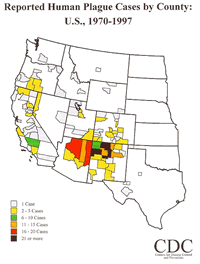
|
 |
Questions
and Answers About Plague |
|
| |
Q. How is
plague transmitted?
A. By fleas that become infected
with bacteria Yersinia pestis that
cause plague. |
Q. How do people
get plague?
A. By the bite of fleas infected with the plague bacteria.
 |
|
Prairie
dogs can harbor fleas infected with plague bacteria.
|
Q. What is
the basic transmission cycle?
A. Fleas become infected by feeding on rodents, such as the chipmunks,
prairie dogs, ground squirrels, mice, and other mammals that are infected
with the bacteria Yersinia pestis.
Fleas transmit the plague bacteria to humans and other mammals during
the feeding process. The plague bacteria are maintained in the blood systems
of rodents.
Q. Could you
get plague from another person?
A. Yes, when the other person has plague pneumonia and coughs droplets
containing the plague bacteria into air that is breathed by a non-infected
person.
Q. What are
the signs and symptoms of plague?
A. The typical sign of the most common form of human plague is a
swollen and very tender lymph gland, accompanied by pain. The swollen
gland is called a "bubo" (hence the term "bubonic plague").
Bubonic plague should be suspected when a person develops a swollen gland,
fever, chills, headache, and extreme exhaustion, and has a history of
possible exposure to infected rodents, rabbits, or fleas.
Q. What is
the incubation period for plague?
A. A person usually becomes ill with bubonic plague 2 to 6 days after
being infected. When bubonic plague is left untreated, plague bacteria
invade the bloodstream. When plague bacteria multiply in the bloodstream,
they spread rapidly throughout the body and cause a severe and often fatal
condition. Infection of the lungs with the plague bacterium causes the
pneumonic form of plague, a severe respiratory illness. The infected person
may experience high fever, chills, cough, and breathing difficulty, and
expel bloody sputum. If plague patients are not given specific antibiotic
therapy, the disease can progress rapidly to death.
Q. What is
the mortality rate of plague?
A. About 14% (1 in 7) of all plague cases in the United States are
fatal.
Q. How many
cases of plague occur in the U.S.?
A. Human plague in the United States has occurred as mostly scattered
cases in rural areas (an average of 10 to 20 persons each year). Globally,
the World Health Organization reports 1,000 to 3,000 cases of plague every
year.
Q. How
is plague treated?
A. According to treatment experts, a patient diagnosed with suspected
plague should be hospitalized and medically isolated. Laboratory tests
should be done, including blood cultures for plague bacteria and microscopic
examination of lymph gland, blood, and sputum samples. Antibiotic treatment
should begin as soon as possible after laboratory specimens are taken.
Streptomycin is the antibiotic of choice. Gentamicin is used when streptomycin
is not available. Tetracyclines and chloramphenicol are also effective.
Persons who have been in close contact with a plague patient, particularly
a patient with plague pneumonia, should be identified and evaluated. The
U.S. Public Health Service requires that all cases of suspected plague
be reported immediately to local and state health departments and that
the diagnosis be confirmed by CDC. As required by the International Health
Regulations, CDC reports all U.S. plague cases to the World Health Organization.
Q. Is the disease
seasonal in its occurrence?
A. No, plague can be acquired at anytime during the year.
Q.
Where is plague most common?
 A. Click on the map at right that shows reported cases
of human plague between 1970-1997 by patient's county of residence. Generally,
plague is most common in the southwestern states, particularly New Mexico
and Arizona. A. Click on the map at right that shows reported cases
of human plague between 1970-1997 by patient's county of residence. Generally,
plague is most common in the southwestern states, particularly New Mexico
and Arizona.
Q. Who is at
risk for getting plague?
A. Outbreaks in people occur in areas where housing and sanitation
conditions are poor. These outbreaks can occur in rural communities or
in cities. They are usually associated with infected rats and rat fleas
that live in the home.
 Return to top of page
Return to top of page
|


